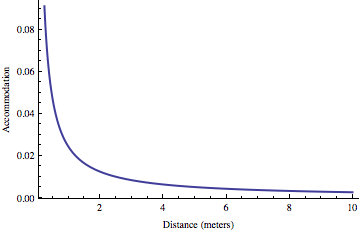On Roger Ebert’s blog, the acclaimed film editor Walter Murch explains what he sees as insurmountable problems with 3D movies:
The biggest problem with 3D, though, is the “convergence/focus” issue. A couple of the other issues — darkness and “smallness” — are at least theoretically solvable. But the deeper problem is that the audience must focus their eyes at the plane of the screen — say it is 80 feet away. This is constant no matter what.
But their eyes must converge at perhaps 10 feet away, then 60 feet, then 120 feet, and so on, depending on what the illusion is. So 3D films require us to focus at one distance and converge at another. And 600 million years of evolution has never presented this problem before. All living things with eyes have always focussed and converged at the same point.
That’s an interesting idea. It’s true the convergence and focus are two separate processes: when you look at something close to you, your eyes tilt in towards each other (convergence), and each eye shifts its focus. The latter process is known as accommodation and involves flexing muscles in the eye to change the power of the lens.
It’s certainly true that 3D movies involve one but not the other, and it’s possible in principle that this has an effect on how we perceive them, but I wouldn’t have thought it was a significant effect in practice. This is way outside of my expertise, but here’s how it seems to me anyway.
The eye is set up so that, when the muscles are completely relaxed, you’re focusing on points that are extremely far away — “at infinity”, as they usually say. The closer you want to focus, the more you have to strain the muscles. The amount of strain is very small for a wide range of distances, shooting up sharply as the distances get small. Here’s a graph I mocked up:
The horizontal axis is the distance to the object you’re looking at, and the vertical axis is the amount of strain the muscles have to provide — to be specific, it’s the fractional change in power of the lens, Delta f/f. In case you’re wondering, I assumed the diameter of the eye is 25 mm and the person’s near point is 25 cm. The graph starts at the near point, so the highest point on the graph is the maximum accommodation the person’s eye is capable of.
The point is that the things you’re looking at in a 3D movie are pretty much always “far away”, as far as accommodation is concerned. The range of examples Murch gives, from 10 feet (i.e. 3 meters) on up, is a good example. Note that the graph is very flat for this range.
If 3D movies routinely involved closeups of a book someone was reading, or the construction of a ship in a bottle, that’d be different. But they don’t. Most of the time, the point you’re looking at is far enough away to be practically at infinity, so your visual system should be expecting not to have to do any accommodation. And of course it doesn’t have to, because the screen is really quite far away (essentially at infinity).
So it seems implausible to me that the accommodation / convergence problem really matters. But this is very, very far from any area of expertise of mine, so maybe I’m wrong.

All the different 3-D schemes (see previous posts in this blog for discussion) work by presenting the eye two separate images, so that the 3-D effect comes from this stereoscopic effect. This mimics reality, as far as it goes, but first it doesn’t go far enough.
What can I do in reality which I can’t do in a 3-D movie (unless I am viewing a hologram, but that is out of scope (pardon the pun) here)? First, I can move my head and look around an object. Second, I can focus on a distant object and closer objects will look blurry and vice versa. Also, looking at a distant object will show closer objects double and vice versa. Thus, as long as there is only the stereoscopic illusion, it won’t be perfect.
How good an illusion it is depends on what the film is. Someone (Ebert?) mentioned that the special effects in The Wizard of Oz are obviously fake, but asked whether that really detracts from the film. Other films (such as, say, a James Bond film) need more convincing special effects. Something like Avatar should benefit even more from 3-D, but somehow it doesn’t (visually—forget the story for now and the gratuitous science-fiction apostrophe, the equivalent of the heavy-metal umlaut). This might be similar to the “uncanny valley” in that at the beginning, the more realistic, the better, but when something is almost but not quite realistic, the last bit of missing realism irritates us even more.
I’m not sure whether the eyes actually change their convergence when watching a 3-D film or not. The typical 3-D camera has two lenses with a fixed distance between them and also with a fixed orientation. Even if they do, I suspect that the effects I mentioned above are more important.
I don’t think convergence matters as much with active shutter 3d glasses. It may pose a problem with passive technology.
As with AS 3D glasses, the shutter of the glasses open and close and a very rapid rate.
I don’t see convergence becoming an issue unless, but possibly with passive 3d glasses.